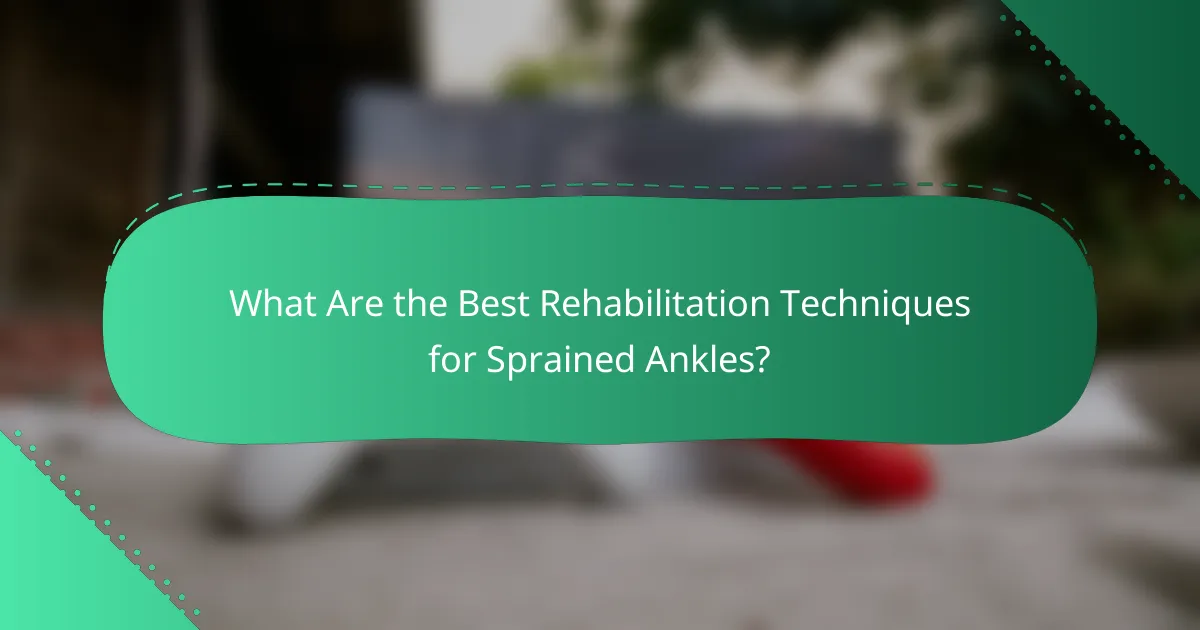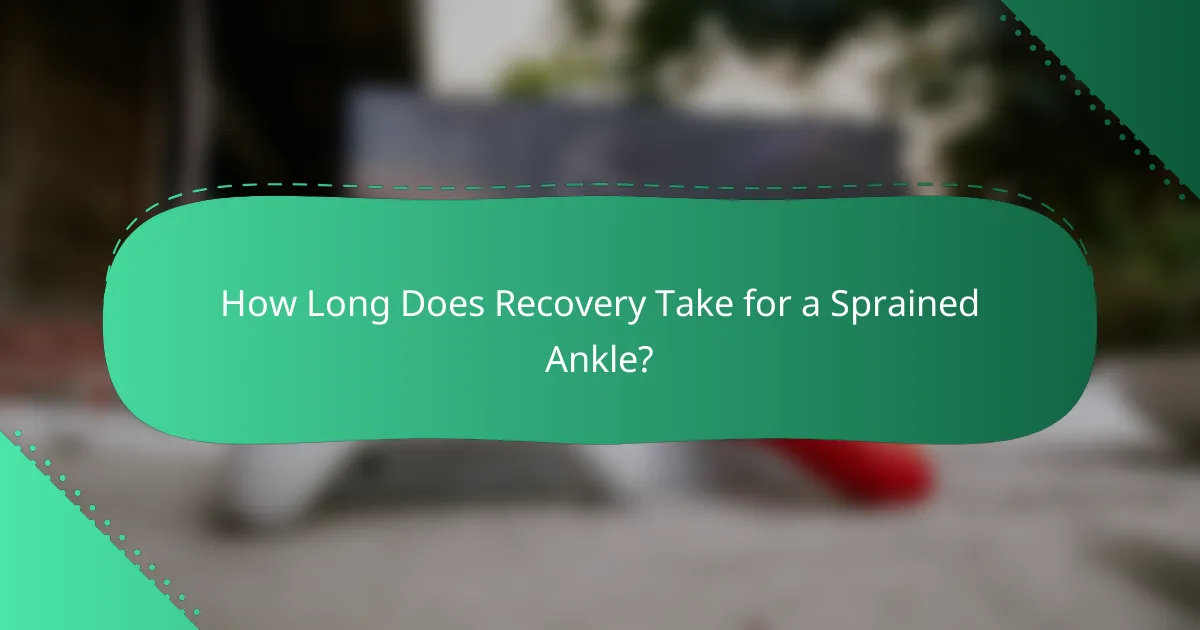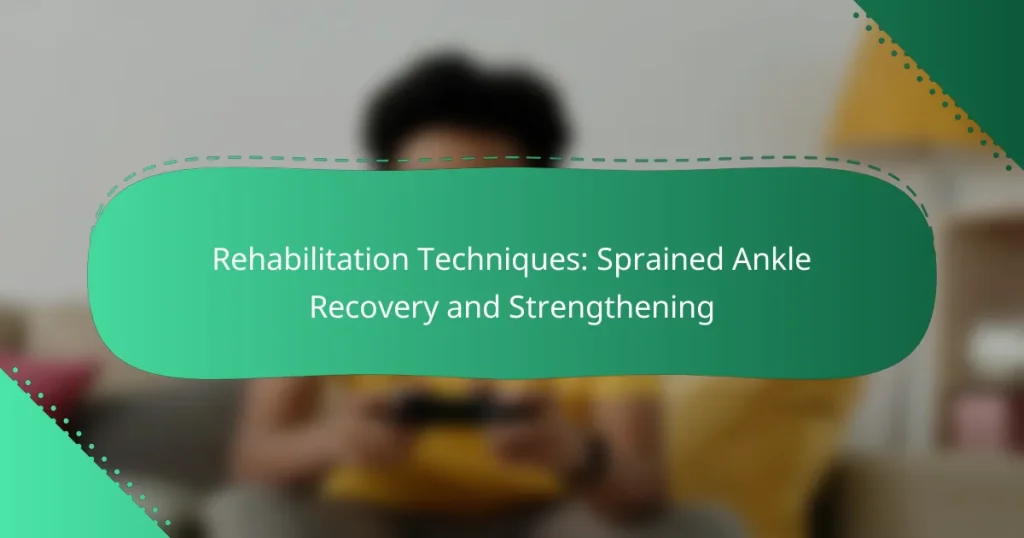Recovering from a sprained ankle requires a comprehensive approach that emphasizes pain reduction, swelling management, and strength restoration. Utilizing techniques such as the R.I.C.E. method, physical therapy, and targeted exercises can significantly enhance healing and improve stability. Tailoring rehabilitation to the severity of the sprain is crucial for optimal recovery and preventing future injuries.

What Are the Best Rehabilitation Techniques for Sprained Ankles?
The best rehabilitation techniques for sprained ankles focus on reducing pain and swelling while promoting healing and restoring strength. Effective methods include the R.I.C.E. method, physical therapy exercises, bracing, progressive loading, and manual therapy.
R.I.C.E. Method
The R.I.C.E. method stands for Rest, Ice, Compression, and Elevation. This approach is crucial in the initial stages of recovery to minimize swelling and pain. Resting the ankle prevents further injury, while applying ice for 15-20 minutes several times a day can help reduce inflammation.
Compression with an elastic bandage supports the injured area and limits swelling. Elevating the ankle above heart level aids in fluid drainage, which can significantly speed up recovery. Aim to follow this method for the first 48-72 hours post-injury.
Physical Therapy Exercises
Physical therapy exercises are essential for regaining strength and flexibility after a sprained ankle. Start with gentle range-of-motion exercises as soon as pain allows, gradually progressing to strengthening activities. Simple movements like ankle circles and toe raises can be effective.
As recovery progresses, incorporate balance and proprioception exercises, such as standing on one leg or using a balance board. These exercises help restore stability and prevent future injuries. Consult a physical therapist for a tailored exercise plan based on your specific needs.
Bracing and Support
Bracing and support can provide stability to a sprained ankle during the healing process. An ankle brace can limit excessive movement, reducing the risk of re-injury while allowing for some mobility. Choose a brace that fits well and offers adequate support without being overly restrictive.
In some cases, taping the ankle can also provide additional support. Ensure that any support method used is comfortable and does not impede circulation. It’s advisable to wear a brace during physical activities until you feel confident in your ankle’s strength.
Progressive Loading
Progressive loading involves gradually increasing the weight and intensity of activities to strengthen the ankle. Start with low-impact exercises, such as walking or cycling, and slowly introduce more challenging movements as your ankle heals. This method helps rebuild strength without overwhelming the injured area.
Monitor your pain levels and avoid pushing through significant discomfort. A good rule of thumb is to increase activity levels by no more than 10% each week. This gradual approach helps ensure a safe return to full activity.
Manual Therapy
Manual therapy, performed by a qualified therapist, can enhance recovery from a sprained ankle. Techniques such as joint mobilization and soft tissue manipulation can alleviate pain and improve mobility. These hands-on methods can complement your rehabilitation program effectively.
Consider seeking a therapist who specializes in sports injuries for optimal results. Regular sessions can help maintain progress and address any lingering issues, ensuring a comprehensive recovery process.

How Long Does Recovery Take for a Sprained Ankle?
The recovery time for a sprained ankle varies based on the severity of the injury. Generally, it can take anywhere from a few days to several weeks, depending on whether the sprain is classified as Grade I, II, or III.
Grade I Sprain Recovery Time
A Grade I sprain is the mildest form of ankle injury, involving slight stretching or microscopic tears of the ligaments. Recovery typically takes about 1 to 3 weeks, allowing for gradual return to normal activities.
During this time, rest, ice, compression, and elevation (RICE) are crucial for healing. Most individuals can start gentle range-of-motion exercises within a few days to prevent stiffness.
Grade II Sprain Recovery Time
Grade II sprains involve partial tearing of the ligaments and usually require a recovery period of 3 to 6 weeks. This level of injury often results in moderate swelling and bruising, making mobility more challenging.
In addition to RICE, physical therapy may be recommended to restore strength and flexibility. Avoiding high-impact activities during recovery is essential to prevent further damage.
Grade III Sprain Recovery Time
A Grade III sprain is the most severe, characterized by a complete tear of the ligament. Recovery can take 6 to 12 weeks or longer, often requiring medical intervention such as immobilization or even surgery.
Following initial treatment, rehabilitation will focus on regaining strength and stability. It’s important to follow a structured recovery plan to minimize the risk of re-injury once normal activities are resumed.

What Are Effective Strengthening Exercises?
Effective strengthening exercises for a sprained ankle focus on rebuilding strength, stability, and flexibility. Incorporating a variety of movements can enhance recovery and prevent future injuries.
Resistance Band Exercises
Resistance band exercises are excellent for ankle rehabilitation as they provide controlled resistance. Start with simple movements like ankle dorsiflexion and plantarflexion, where you pull the band towards you and push it away, respectively.
Perform each exercise for 10-15 repetitions, gradually increasing resistance as your strength improves. Ensure that movements are slow and controlled to avoid re-injury.
Balance Training
Balance training is crucial for regaining stability after an ankle sprain. Simple exercises include standing on one leg or using a balance board to challenge your proprioception.
Try to hold each position for 20-30 seconds, gradually increasing the duration as your balance improves. Incorporating dynamic movements, like reaching with the opposite hand while balancing, can further enhance stability.
Calf Raises
Calf raises help strengthen the muscles around the ankle, which is vital for overall stability. Stand on the edge of a step with your heels hanging off, then raise your body by pushing through your toes.
Start with 10-15 repetitions and aim for 2-3 sets. As you gain strength, consider adding weights or performing the exercise on one leg to increase difficulty.
Toe Taps
Toe taps are a simple yet effective exercise to improve ankle mobility and strength. While seated, lift your toes off the ground and tap them back down, focusing on controlled movements.
Perform this exercise for 1-2 minutes, ensuring that you maintain a steady rhythm. This can be done multiple times a day to promote circulation and flexibility in the ankle joint.

What Are the Signs of a Severe Sprain?
A severe sprain often presents with significant symptoms that indicate a more serious injury. Key signs include extreme swelling, difficulty bearing weight, and ongoing pain that does not subside with rest.
Swelling and Bruising
Swelling and bruising are common indicators of a severe sprain. When the ligaments are damaged, fluid accumulates in the affected area, leading to noticeable swelling. Bruising occurs due to bleeding under the skin, which can vary in color from red to purple and may extend beyond the immediate injury site.
To assess the severity, compare the injured ankle to the uninjured one. If the swelling is significantly greater, it may suggest a more serious sprain. Applying ice and elevating the ankle can help reduce swelling in the initial stages.
Inability to Bear Weight
Inability to bear weight on the injured ankle is a critical sign of a severe sprain. If you find it painful or impossible to put any weight on the foot, it may indicate a complete tear of the ligaments. This is a strong signal to seek medical evaluation.
As a guideline, if you cannot walk without significant pain, consider using crutches to avoid further injury. A medical professional may recommend imaging tests to determine the extent of the damage.
Persistent Pain
Persistent pain that lingers despite rest and home treatment is another sign of a severe sprain. While some discomfort is normal after an injury, pain that intensifies or does not improve over a few days can indicate a more serious issue.
Monitor your pain levels and consider over-the-counter pain relief options, but if the pain persists beyond a week, consult a healthcare provider for a thorough assessment and potential treatment options.

How Can I Prevent Future Ankle Injuries?
To prevent future ankle injuries, focus on proper footwear, a consistent strengthening routine, and effective warm-up exercises. These strategies help stabilize the ankle and improve overall joint health.
Proper Footwear
Wearing the right shoes is crucial for ankle injury prevention. Look for footwear that provides adequate support, cushioning, and a non-slip sole. Athletic shoes designed for your specific activity, whether running, basketball, or hiking, can significantly reduce the risk of sprains.
Ensure that your shoes fit well; they should not be too tight or too loose. Regularly replace worn-out shoes, as they lose their supportive qualities over time.
Strengthening Routine
Incorporating a strengthening routine into your weekly schedule can enhance ankle stability. Focus on exercises that target the muscles around the ankle, such as calf raises, ankle circles, and resistance band workouts. Aim for at least two to three sessions per week.
Consider including balance training, like standing on one leg or using a balance board, to improve proprioception and coordination. This can help your body respond better to unexpected movements, reducing injury risk.
Warm-Up Exercises
Effective warm-up exercises prepare your muscles and joints for activity, minimizing the chance of injury. Spend about 5-10 minutes on dynamic stretches that engage the ankle, such as leg swings and toe taps, before any physical activity.
Incorporate movements that mimic the activity you plan to perform, ensuring your body is ready for the specific demands. This practice not only enhances performance but also protects against potential sprains.

What Are the Benefits of Early Rehabilitation?
Early rehabilitation for a sprained ankle can significantly enhance recovery speed and effectiveness. Engaging in appropriate rehabilitation techniques shortly after injury helps reduce pain, improve mobility, and prevent long-term complications.
Improved Range of Motion
Early rehabilitation techniques focus on restoring the range of motion in the affected ankle. Gentle stretching and mobility exercises can help prevent stiffness and promote healing. Aim to start these movements within a few days post-injury, as long as they do not cause significant pain.
Reduced Swelling and Pain
Implementing early rehabilitation strategies can effectively minimize swelling and discomfort. Techniques such as ice application, compression, and elevation are crucial in the initial days. Following this, gentle exercises can help promote circulation, further reducing inflammation.
Strengthening Muscles and Preventing Re-injury
Once the initial pain and swelling subside, strengthening exercises become vital. Focus on low-impact activities that target the ankle and surrounding muscles. Incorporating balance training can also enhance stability, reducing the risk of future sprains.
Psychological Benefits
Engaging in early rehabilitation can provide psychological advantages, such as increased confidence in the healing process. Knowing that you are actively participating in your recovery can alleviate anxiety and promote a positive mindset. Setting small, achievable goals during rehabilitation can further boost motivation and adherence to the recovery plan.


